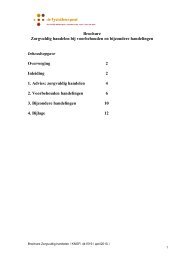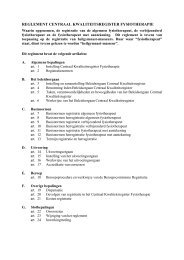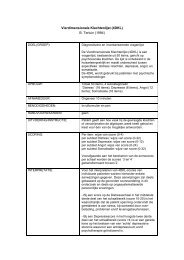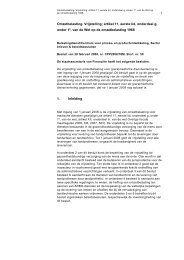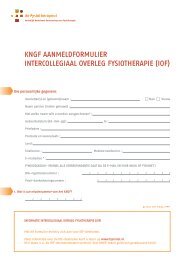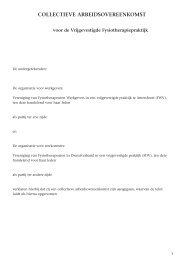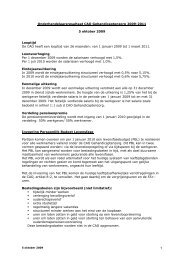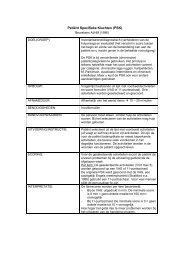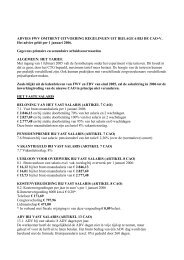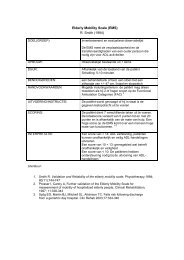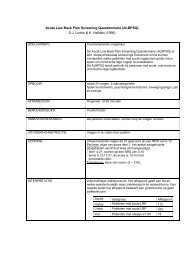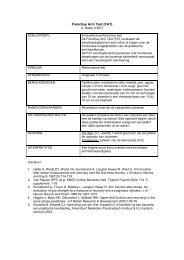Acupuncture and dry-needling for low back pain (Review)
Acupuncture and dry-needling for low back pain (Review)
Acupuncture and dry-needling for low back pain (Review)
You also want an ePaper? Increase the reach of your titles
YUMPU automatically turns print PDFs into web optimized ePapers that Google loves.
Grant 1999<br />
Methods<br />
Participants<br />
Interventions<br />
Outcomes<br />
Notes<br />
- R<strong>and</strong>om numbers were used (method not described) to generate a sequence of sealed envelopes containing the<br />
treatment code, the next available envelope being opened on the patient’s entry into the trial.<br />
-Outcome assessors were blinded.<br />
-Funding: Grant from the Trustees of the Liberton Hospital Endowment Funds<br />
-Setting: Outpatients clinic in the United Kingdom<br />
-In<strong>for</strong>med consent: not reported<br />
-The study was approved by the Lothian Research Ethics Committee<br />
-Fol<strong>low</strong>-up: 57 out of 60 r<strong>and</strong>omised<br />
-Analysis: No intention-to-treat. Mann-Whitney U-tests <strong>for</strong> between group differences<br />
60 patients aged 60 years or over, with a complaint of <strong>pain</strong> of at least 6 months duration<br />
Diagnoses: chronic <strong>low</strong>-<strong>back</strong> <strong>pain</strong>.<br />
Excluded: treatment with anticoagulants, systemic corticosteroids, dementia, previous treatments with acupuncture<br />
or TENS, cardiac pacemaker, other severe concomitant disease, inability of patient or therapist to apply TENS<br />
machine<br />
Mean age: 73.6 years old<br />
6 males <strong>and</strong> 54 females<br />
Previous treatments: not reported<br />
1) Two sessions of manual acupuncture weekly <strong>for</strong> 4 weeks, i.e. eight sessions in total. The needles were of a st<strong>and</strong>ard<br />
size (32 gauge, 1.5 inch length with guide tube). Points were chosen <strong>for</strong> the individual patient as in routine clinical<br />
practice, only using points in the <strong>back</strong>. Six needles were used on average at each treatment with a minimum of two<br />
<strong>and</strong> a maximum of eight. Treatment sessions lasted <strong>for</strong> 20 minutes.<br />
R<strong>and</strong>omized to this group: 32. Two dropped out during the study. Reasons: influenza <strong>and</strong> dental problem<br />
2) TENS: St<strong>and</strong>ard machine (TPN 200, Physio-Med-Services) using 50 Hz stimulation with the intensity adjusted<br />
to suit the patient, again as a routine clinical practice. The patient was given her/his own machine to use at home,<br />
<strong>and</strong> instructed to use it during the day as required <strong>for</strong> up to 30 minutes per session to a maximum of 6 hours per<br />
day. She/he was also seen <strong>for</strong> 20 minutes, twice weekly, by the physiotherapist, ensuring the same contact with him.<br />
At each visit, symptoms were reviewed, treatment discussed <strong>and</strong> the optimum use of the TENS machine ensured.<br />
R<strong>and</strong>omized to this group: 28. One dropped out due to acute depression<br />
Co-interventions: The patients were advised to continue existing medication but not to commence any new analgesics<br />
or any additional physical treatments <strong>for</strong> the duration of the trial<br />
1) Pain: visual Analog scale (0 to 200 mm).<br />
2) Pain subscale of the 38-item Nottingham Health Profile part 1.<br />
3) Analgesics consumption<br />
4) Spinal flexion<br />
These outcomes were taken at baseline, 4 days <strong>and</strong> 3 months after last treatment session<br />
Costs: not reported<br />
Complications: 3 acupuncture patients reported dizziness <strong>and</strong> 3 TENS patients developed skin reactions. (Comparison<br />
07.08)<br />
The two groups appear different at baseline with respect to the four outcome measures. Patients in the acupuncture<br />
group have higher VAS <strong>and</strong> NHP <strong>pain</strong> scores, reduced spinal flexion <strong>and</strong> <strong>low</strong>er tablet consumption compared to the<br />
TENS group<br />
Because the authors had not adjusted <strong>for</strong> baseline values, no conclusions can be made based on this study<br />
We could try to obtain raw data from authors <strong>and</strong> run ANCOVA, but the data is also skewed <strong>and</strong> trans<strong>for</strong>mation is<br />
not appropriate<br />
Results:<br />
<strong>Acupuncture</strong> <strong>and</strong> <strong>dry</strong>-<strong>needling</strong> <strong>for</strong> <strong>low</strong> <strong>back</strong> <strong>pain</strong> (<strong>Review</strong>)<br />
Copyright © 2011 The Cochrane Collaboration. Published by John Wiley & Sons, Ltd.<br />
35



